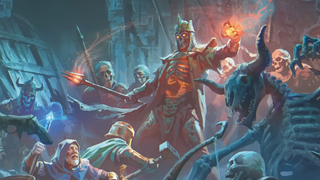D&D is about to finish its big 2024 overhaul—and while I've got my opinions on the whole exercise, I've not been a complete curmudgeon about it. I even happen to think the Dungeon Master's Guide is downright good, if a little surface-level, but hey—it's an introductory document, we can leave the specific advice for content creators and harrowing in-session arguments.
The 2024 Monster Manual, which'll arrive February 18, 2025 (yes, it is a little confusing) brings 85 new monsters to the table when compared to its 2014 counterpart. What's more, the whole catalogue of mooks has been revised, as explained in a recent interview with Todd Kenreck hosted on D&D's YouTube channel.
Design lead Jeremy Crawford and senior designer F. Wesley Schneider went over the team's goals for this improved tome, and it's all honestly sounding quite good. The proof will be in the black pudding (that's a D&D monster, I don't just have a hankering for blood sausage), but I'm liking what I'm hearing.
Namely, Wizards is tackling one of 5e's oldest hang-ups—CR is a goddamn wonky system for balancing combat encounters at best. For the uninitiated, CR—or "Challenge Rating"—is a number that says 'four adventurers of this level should have a moderately difficult time fighting this thing'. For example, you should be able to throw a CR six monster at a group of four adventurers, who are each level six.
Problem being, D&D 5e is such an oddly balanced system that it was always difficult to work with for a number of reasons—action economy, magic items, power bloat with new subclasses, you can pick your poison. It's an issue that only gets more problematic the more complex, and powerful, the monster becomes. Luckily, with the game's biggest bads, the team has changed its design philosophy.
As Crawford explains: "A decade ago, the way we calculated CR was focused on 'if the DM chooses the most powerful option every round, here is the monster's CR'. Many of us as DMs found that sometimes we don't want to choose the most deadly option every round—but then that also often led to a monster feeling weaker than it should. We have now changed our entire methodology … no matter which sequence of legendary actions you pick, that monster is still going to be on CR."
Essentially, there's less pressure on the DM to fully interpret the strategy of the monster they're using in order to use it optimally—work with a suggested order of operations, and you'll be fine, in theory. "We lay [this] out," says Schneider, "and we say to DMs—hey if you see these abilities? Prioritise them, these are things you should be focused on."
Later on, Crawford elaborates that there's a section in the book designed to help DMs get their dice wet: "[If] as a DM you're stumped on what the monster should do, we put in 'always look for the following abilities, and prioritise using them, IF your goal is bringing the hurt' … we also wanted to make it far easier for a DM to bring the thrills and the terror when that's appropriate for their campaign."
This streamlining of information overload extends to stuff like spellcasting and legendary actions, too: "We took a number of gameplay elements that used to exist outside the stat block in things like lair actions—and moved those into the stat block itself. To not only make the DM's life easier by having everything they need to know on running the creature right in front of them in the stat block, but also, this was a chance for us to bring in new abilities."
As for what those new abilities are? Crawford claims that Wizards has made a real effort to differentiate its groups of monsters with proper mechanical flavour. For example, as Crawford explains, most vampire-type enemies are going to have some way to become slippery in combat, recalling a time where the 2024/2025 version's Vampire Spawn moved without provoking opportunity attacks, surprising a table of 2014 vets.
"As you go up in CR … that's where you'll see more and more new things. Here's one example: When you get to the vampire section … not only are there more vampires than before—many of our monster families have expanded—we not only have a new lower-CR option in the vampire section, we also have a new higher-CR option, and another new option in between. We have three brand-new vampires."

One point, brought up by Schneider, does genuinely excite me—monsters should also come with examples of where in a campaign they might pop up, and what plot hooks you could use to explain their presence. For example, Animated Objects "also [include] a table of: 'Why is this object animated?' And it's like, maybe it's fey trickery that did it, maybe a wizard created it, maybe the things are possessed or something. Every one of those possibilities? That's a completely different story."
In fact, the Monster Manual sounds like it's been reimagined as a vehicle for story, widening its breadth of critters. There's a bunch of new NPCs—performers, pirates, and the like—but Crawford also explains that there's been an emphasis on implementing BBEGs, also known as "big bad evil guy(s)". These are high-level creatures that might be the archenemy of an entire campaign.
"We wanted a DM to be able to look through the book, and essentially have a menu of options for 'what is the Big Bad at the end of this campaign?' Before you had some great options in the dragon category, the undead category, and the fiend category… and that was kind of it. We made sure that you have an option in, heck, even the construct category, the celestial category, the ooze category, the fey category, and so on, so forth." In other words, "we wanted the Tarrasque to have some fighting buddies."
We made sure that you have an option in, heck, even the construct category, the celestial category, the ooze category, the fey category, and so on."
Jeremy CrawfordIn terms of finding all these new monsters in the book, things've been streamlined there, as well. There'll be tables for creatures by CR, name, type, environment, and sub-groups such as fiend or demon. "There's a lot more infrastructure in this Monster Manual than in the 2014 one to help DMs prepare and design adventures." As Schneider puts it, "if you look up a Pit Fiend. You will not find it under D. You will find it under P. For Pit Fiend." Praise Mystra.
All in all, a solid set of positives—again, players'll have to spend some time with the Monster Manual to see if it's worth the entry price. Not because I think Schneider and Crawford are lying about the quality of life boosts, which would be weird, but because the real nitty-gritty will lie in how these monsters are designed, as well as how they slot into the other rules revamps, such as the Player's Handbook.
Still, if you've been enjoying the refresh so far, the 2024 Monster Manual doesn't sound like it's going to disappoint—and the art showcased in the above video does look downright gorgeous, so there'll be some pretty pictures to get your creative juices going while you figure out how to TPK your party for being late to the session, again.

 1 day ago
2
1 day ago
2









 English (US) ·
English (US) ·